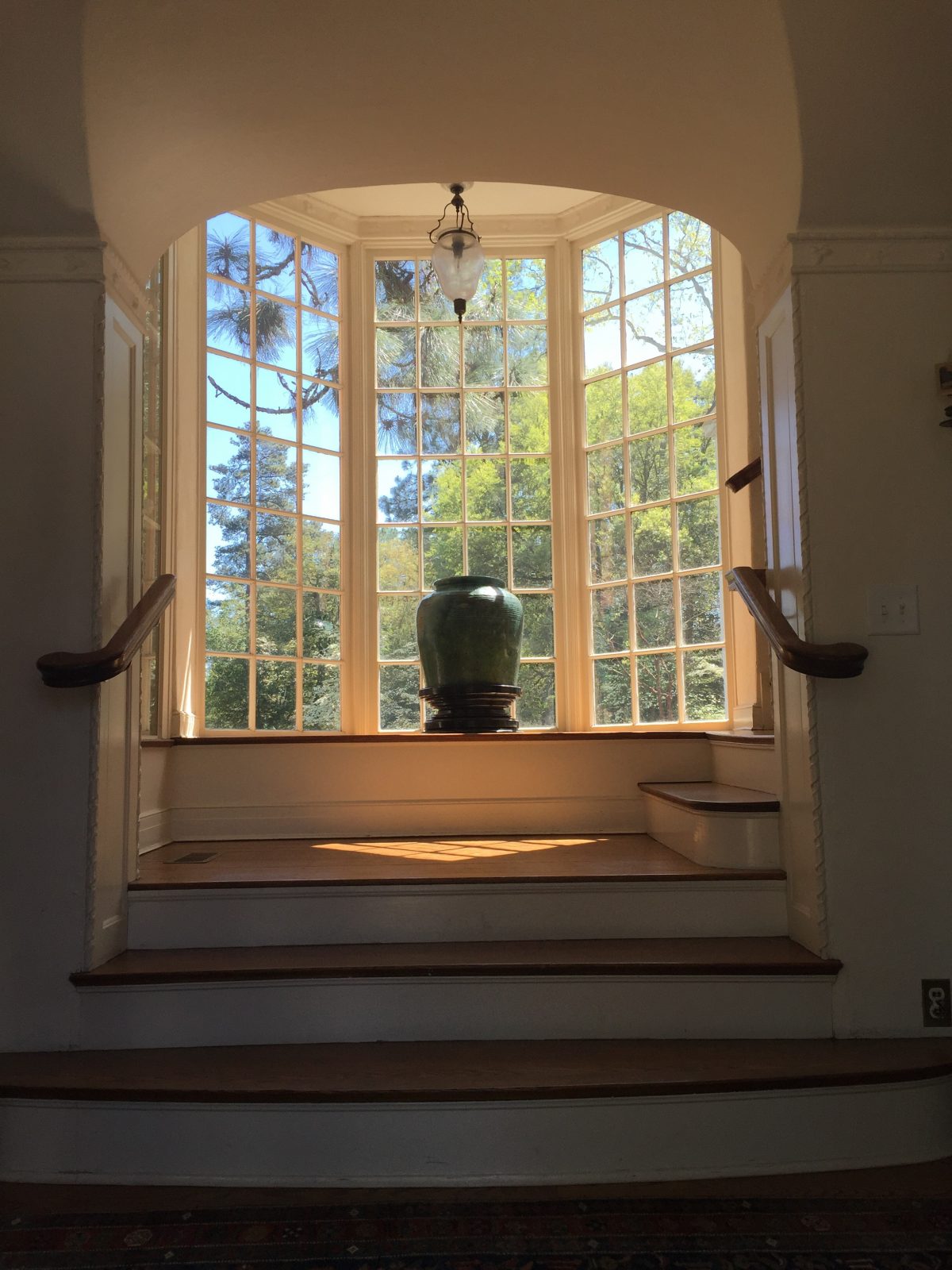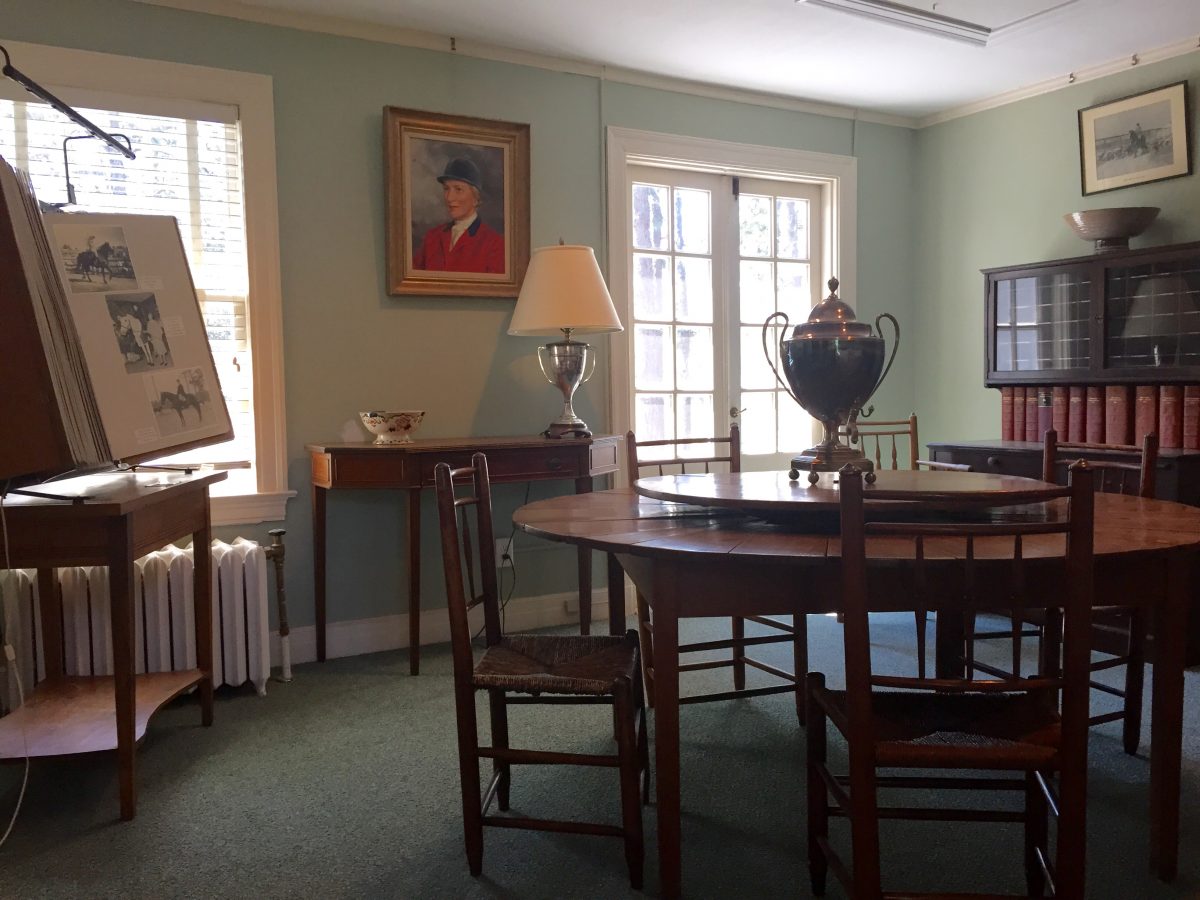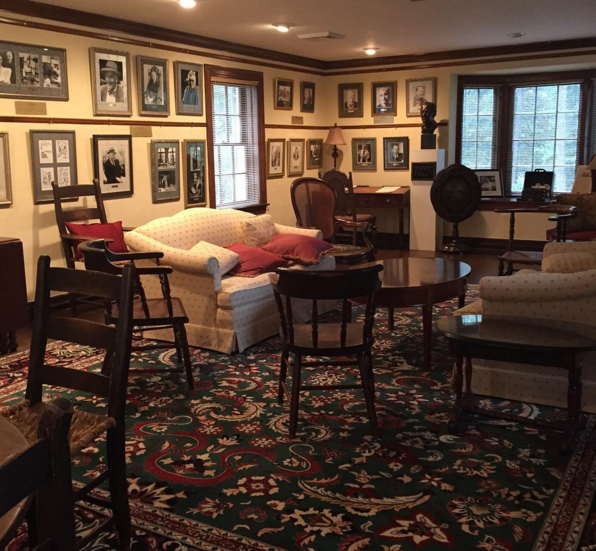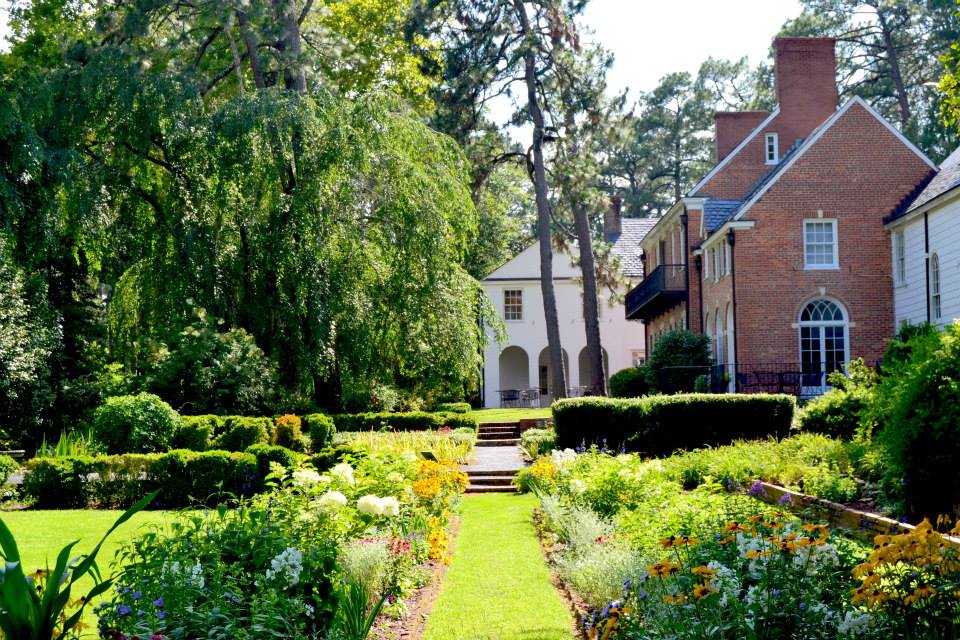The Boyd House is open to the public from 10 AM – 2 PM, Monday through Friday.
You are welcome to stop by and enjoy a tour of this beautiful home or the Weymouth Gardens!
Group and individual tours are available upon request. For more information, call (910) 692-6261.
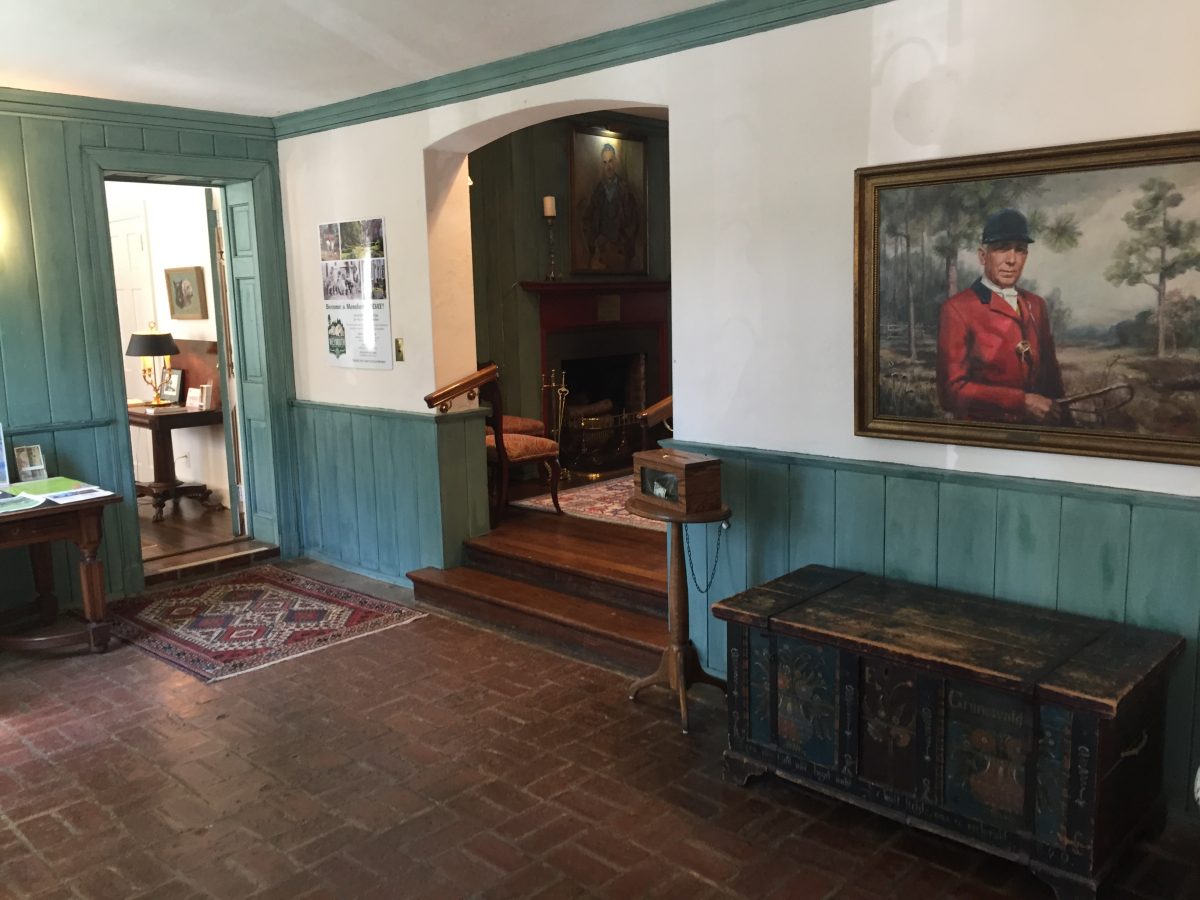
Entrance and Vestibule
In the original house design, what is now the main entrance was a side terrace. The 18th -century wooden painted chest is from Pennsylvania, but of German origins. The portrait in oil is of “Pappy” Moss, past Master of the Moore County Hounds.
There also hangs a portrait of the Boyd brothers, James and Jackson, who were the first Masters of the Hunt for the Moore County Hounds, which they founded in 1914.
Walk up the two steps to the Vestibule, once James Boyd’s office. (Because of a lack of privacy, a 5-bedroom addition was made to the house in 1932, and his study was relocated upstairs.) Over the mantel hangs a portrait of James Boyd, painted by Arthur Frank.
On the smaller wall leading to the original entryway, hangs a poem by James Boyd.


Outside the Library hangs a photographic tribute of the most recent inductees into the NC Literary Hall of Fame. Next to that is the bust of Sam Ragan, the NC Poet Laureate who, in 1979, spearheaded the effort to “save” Weymouth.

Library
This room has always been the Library. The books in glass cases are from the original Boyd collection or are copies of James Boyd’s works and those of his friends. The 1925 edition of Boyd’s first novel, a Revolutionary War saga, Drums, is displayed showing the cover and chapter illustrations originally painted by N.C. Wyeth. The book is still in print.
Over the mantle are photos of James Boyd taken by famous photographer Doris Ulmann (for his publisher; Scribners).
Displayed is a picture of the ship “Serapis,” and a model of the “Bonhomme Richard” which were used by Boyd while writing Drums.
The charcoal portrait near the door is of Struthers Burt, a former professor at Princeton who befriended and encouraged James Boyd as a writer. He and his author wife lived next door, where Penick Village now stands.
The Garden Room
Part of the five-room Yeoman’s addition to this wing, Katharine Boyd used this room for entertaining and flower arranging. Lovely demi-lune windows with leaded detailing bring in the southeastern sun. A covered loggia outside the French doors echoes the arches.
Literary guests staying in the house would bring folding canvas chairs out on the lawn to tell their stories under the shade of the 100-year-old sycamore tree. Wouldn’t you like to have been a branch within hearing on such an occasion? Son Daniel also kept his 7-foot long gopher snake, the gift of the Bronx Zoo, in this room. His model trains and villages were also set up here with landscapes in different layouts. He eventually became a city-planner in California!
In this room, you will also find Moore County pottery on display from Dr. Alexander McLeod’s collection.
Original Entrance Hall & Foyer
Leading from the Vestibule is the original entrance to the house. Open the original front door and walk a few yards towards the great lawn. Turn around to view the house in all its beauty. It is better seen and understood from this vantage point. This Southern Colonial Revival house was created by Aymar Embury, II, a well-regarded New York architect. It was constructed in 1920-21.
Above the piazza to the left is a summer sleeping porch (the house was not air-conditioned). The family bedrooms, now used by writers-in-residence all connected to this porch.
Return to the main hallway and the staircase which was originally double. The long view through the oriel window leads to an equestrian meadow where once a golf course was laid out. Traditionally, the returning Hunt (The Moore County Hounds) rode down this allee on their way to breakfast at Weymouth.
Detailed trim on the stucco walls and casements include dogwood, camellias, and peaches resonant of local horticulture. The glass case contains the Moore County pottery collection of Robert Mason. The large pottery vase was the gift of Lena Stewart.
Embury added detailed moldings to the neo-classical entablature reflecting the local horticulture. Peaches, Camellias, Dogwood, etc., are easy to detect.
Originally there was a double staircase. The iconic oriel window opens the entrance to the long view of the landscape. Originally the meadow was a golf course, but for almost 100 years it has been the equestrian allee from which fox hunters returned to breakfast at Weymouth.
The glass case contains the Moore County pottery collection of Robert Mason. The large pottery vase was the gift of Lena Stewart. The hall walls are enhanced by artwork and textiles original to the house.

The Great Room
Step down from the foyer of the home’s original front entrance into the Boyd’s living room where five long windows and five tall glazed exterior doors provide views to the piazza and the lawns.
The classical proportions and finely crafted details of this 21 x 54-foot space create a light-filled and elegant background to the hospitality is has seen for almost one hundred years.
Katharine Boyd recounted the history of the acquisition of the magnificent, 200-year-old, hand-carved pine mantle and fireplace surround. “It was taken from the Sara Blue farmhouse nearby. This house was being rebuilt. Mr. Boyd noticed it when he was riding by. He asked the owner if he would sell him the fine old mantles that were being replaced.” All three were purchased. One is in the Weymouth library and another is in the old Boyd Room in the Southern Pines Planning Office (the first town library).
Mrs. Boyd reported that “Aymar Embury admired them so much, he cleverly used the same carved motif in the reeded plasterwork of the windows and doors.”
The detail of the central ceiling medallion is echoed in the demi-lune leaded over-door windows. The fluted pilasters with delicate capitals finish the interior doorways while the cornices and anthemion frieze complete the room’s decorative elements with dignity and restraint. The room’s original silver sconces add to the authenticity of the architecture.
The oil portraits are of Katharine Boyd and James Boyd’s grandfather, James Boyd, Sr.
James Boyd’s son recalled the surprising discovery he made while walking through the living room one morning. A great bear of a man was lying in front of the fireplace sleeping noisily. The writer Thomas Wolfe had arrived for the first time, unannounced, on the four a.m. train. He climbed the hill with his luggage and discovered Weymouth locked and the family asleep. After a search, he discovered an unlocked window, climbed through it and made himself completely at home!
The Great Room continues to delight all who come to enjoy Weymouth’s hospitality. Musical concerts, exhibits, lectures, plays and social events are still the order of the day.
The Dining Room

On the far end of The Great Room, enter the Dining Room. Of all the rooms in the house, this room is the one to most resemble the way it was when the Boyds lived here. In an article published in 1939 in Art & Decoration, Katharine reported that the heart pine paneling came from an old house nearby.
The long table which could accommodate many guests was crafted from local pine. The chest facing the room’s entry doors is also original to the room, as are the two captain’s chairs (once a set of 10).
Candlelight alone provided illumination. Nancy Boyd Sokoloff fondly remembered her parents reading to her from Dickens and Joel Chandler Harris, as they snuggled on a small sofa in front of the Franklin stove – her father, using different accents for the characters, and omitting those paragraphs which he felt were inappropriate for the children to hear!

Now walk back through The Great Room to the staircase in the original entrance hall. Climb the stairs and pause to view original photographs of the home’s interior, hanging in the hallway.
The rooms were furnished simply with old family antiques and handmade rugs. Each room had a fireplace or Franklin stove which burned wood or coal. There was no central heating until after World War II. Turn left at the top of the stairs and walk straight down the hallway to The St. Andrews Room.
The St. Andrew’s Room
In 1932, Alfred Yeomans enlarged this section of the house by five rooms. This room became the new master bedroom. Pastel portraits of sons Daniel and “Jamie,” as well as Katharine’s Audubon prints remain where she hung them. Tea was often served in front of the fireplace with the children attending.
The long oak table in this room was the Stewart dining table from the old Buchan farm on Drowning Creek. The donor, Kate Stewart suffered at an early age the same rheumatoid arthritis that afflicted Katharine. A college education was provided to Kate who never forgot her friend’s generosity. Her sister Lena was given piano lessons to encourage her talent as well.
Return to the hallway and enter the first door on the left to what was originally the closet and dressing room, but now houses the Hunt Room.
The Hunt Room
Originally this room was a guest room, but in 1932 it became the dressing room for the master bedroom.
Today, it is filled with memorabilia from the Moore County Hounds which was started by James and his brother Jackson in 1914. It is the oldest continuous Hunt in N.C. Trophies, riding pinks, pictures and a portrait of Ginny Moss, reflect the equestrian past of the Boyds and Southern Pines. The handcrafted, “Lazy Susan” table is original to the house.
The oak desk belonged to Katharine Lamont Boyd. The labels still attached to its 60 pigeonholes attest to her values, interests, and “the kaleidoscope pattern of her life.” Among the titles are, “Family Letters,” “Sorrento,” (her family’s summer home in Maine), “Music and Art,” “Birds and Dogs,” Fine Things to Keep,” “Pictures,” “Library,” “Songs,” “Unanswered,” “Welfare,” “Citizens,” “Editorial Data,” and two are labeled “Maternity.” (She founded the Moore County Maternity Welfare Committee) “Dr. Swett,” is also named on another pigeonhole. His daughter Rebeccah served as Katharine’s “spy,” regularly reporting the names of those distressed citizens in need of her financial help.
The wooden section of the stable, along with the kennels, was built in 1914 when the Boyd brothers first founded the Moore County Hounds. In 1928, the masonry additions were added.

The local equestrian community has generously furnished the memorabilia that celebrates this sporting tradition. Trophies, riding pinks, pictures and a portrait of Ginny Moss, reflect the equestrian past of the Boyds and Southern Pines.
James Boyd’s biographer wrote that his “aristocratic sensibility evidenced radically democratic ideas. Even the hunt, he believed, should belong to the town and no one who was seriously interested in hunting should ever be refused a place whether he could afford to dress properly or not.”
Boyd wrote of farmers on horses more accustomed to pulling wagons than jumping fences.
“We laid hound on, and off we went,” Boyd described one New Year’s Day hunt. “When we struck the fence it sounded like the collapse of the Crystal Palace. I looked back (and) there was a cloud of smoke and flying timbers, and when the air cleared, the fence was gone, but all the field were on the right side, riding to beat hell!”
Writers’-in-Residence Rooms
Five bedrooms and three baths, and a small kitchen are found in this part of the house. All the rooms were used by the family and servants for sleeping. The Fitzgerald Room was originally a sewing room while the tiny blue room served as a walk-in closet.
N.C. published writers and poets are welcomed here all during the year for a maximum of two weeks. They find at Weymouth, the comfort, beauty, and serenity that helps to encourage their creativity.
James Boyd’s Study: N.C. Literary Hall of Fame
James Boyd used this enlarged study (part of the 1932 addition) for “writing.” While standing in front of the middle window (with built-in ledge) James Boyd was able to keep an eye on the stable and kennels while he dictated his books and stories to a secretary or a Dictaphone. He enjoyed writing he said, but the horses and hounds were his passion!
Established by the N.C. Council of the Humanities as a place to honor gifted N.C. writers and poets, the N.C. Literary Hall of Fame inducts new members biennially at Weymouth. Jonathan Daniels thought the location was appropriate because this gathering place had “launched the Southern Literary Renaissance.” It celebrates not only contemporary literature but also the proud and diverse past that informs and nurtures the writers of today and tomorrow.
The mahogany drop-leaf table is original to the house, as are the rush-seated chairs and a burgundy wingback chair.
The desk is from the U.S. House of Representatives – Daniel Lamont, Katharine Boyd’s father, told her it had been used by Abraham Lincoln, but there is no written proof of this.
Weymouth’s mission closely follows Katharine Boyd’s wish that the estate become “a place where writers and artists could gather and work, where men and women could explore new thought, and where sparks of creativity could be struck, as they had when it was her home.”
Preservation of Landscape and Gardens
The entire twenty-six acres are being managed under a new Master Plan supported by the N.C. State Historic Preservation Office as well as the U. S. Fish and Wildlife Service and gifted volunteers.
Alfred B. Yeomans, a Boyd cousin, was the landscape architect who designed the series of garden “rooms.” The iconic Japanese Weeping Cherry trees were planted over a century ago (and bloom during the last two weeks of March). His use of mostly native plant materials defines the greater landscape.
Nearer the house, formal parterres and a long perennial border are flourishing. The old swimming pool was cleverly turned into a water feature, while the long brick serpentine wall – modeled after Jefferson’s wall at the University of Virginia – closes the final “room.”
Area Garden Clubs, experienced volunteers, and generous donations have made this work possible.
The small building by the pool is the original carriage house.
The replanting of longleaf pines [pinus palustris] is ongoing, while invasive vines and trees are being removed. Weymouth is the Gateway to the oldest virgin longleaf pine forest in the world. It is now under the management of “Weymouth Woods Nature Preserve” – a gift to the state from the Boyd family.
The 1914 stable and dog kennels are also being conserved, so horses are once again part of our landscape.
“This is really the most beautiful country I know.” James Boyd wrote “[It] has a certain wildness without being desolate . . . solitude without loneliness.
The property has been listed on the National Register of Historic Places since 1979.
Weymouth is sustained by your generous donations. Find more information on becoming a Member of the Friends of Weymouth or to become a Sustaining Donor here or call (910) 692-6261 for details.
Weymouth Center for the Arts & Humanities is a 501(c)3 non-profit organization.

